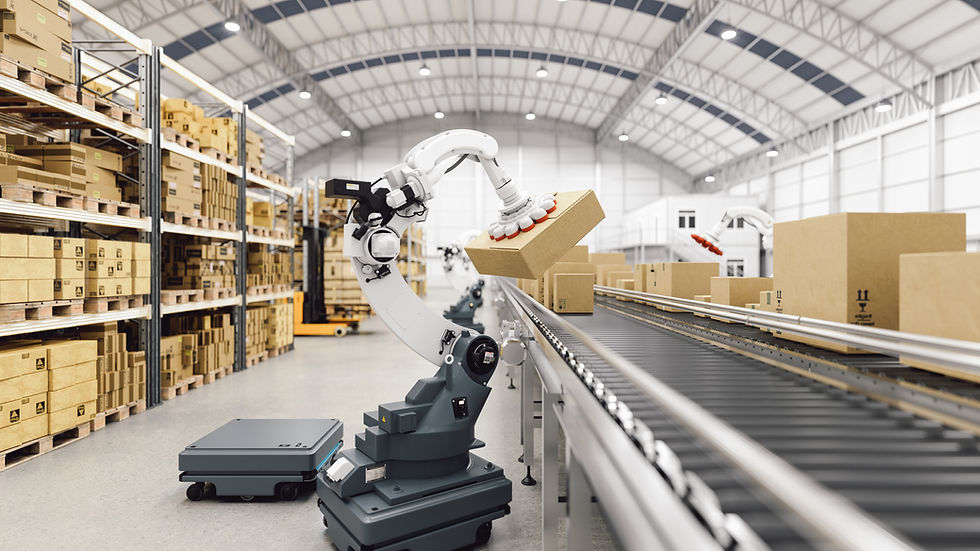Auditing the AI Agent Revolution
- Bradley Rogers
- Aug 31
- 5 min read
For my Doctorate in Business Administration (DBA) research, I set out to answer a critical question facing every modern enterprise: Where are AI agents—the autonomous decision-making systems of the future—delivering the most value, and why?
My research methodology was unique. I conducted a Deep Scholarly Sweep (2019–2025), not just to review the literature, but to put artificial intelligence itself to the test. My process involved an independent audit of three different AI tools, each given the same rigorous prompt to identify the most proficient domains for AI agents. The goal was to synthesize their findings and validate them against my own independent research. This post shares my findings, highlighting the domains leading the charge and offering a practical playbook of what works and what to avoid.
A PRISMA-Powered Search: Auditing the AI's Research
The foundation of my research was a systematic review process, mirroring the PRISMA (Preferred Reporting Items for Systematic Reviews and Meta-Analyses) framework. This provided a robust, academic framework to filter through a vast landscape of information. The combined AI reports and my own research yielded a significant body of evidence. One AI's search process alone initially retrieved over 6,000 articles, which, after a rigorous screening, yielded around 20 highly relevant studies. Another AI's review identified 111 initial sources, ultimately including 60 for its final analysis. This data-driven approach allowed me to move beyond anecdotal evidence and focus on what the academic and industry literature truly supports.
The Most Proficient Domains for AI Agents
My audit and independent research confirmed that a domain’s proficiency in using AI agents is not just about the technology; it's about the environmental factors that support it. The most successful domains share a core set of characteristics: a high frequency of decisions, clear and measurable rewards, and low-latency data availability.
Based on my analysis, the top domains for AI agent deployment are:
Logistics & Warehousing: This domain consistently ranked at the top of my audit. In a warehouse environment, AI agents in the form of autonomous mobile robots (AMRs) make countless decisions every minute. Success is instantly measurable through metrics like fulfillment speed, picking accuracy, and reduced labor costs. This operational environment, with its abundant IoT sensor data and clear goals, allows agents to achieve remarkable efficiency gains, including 50% productivity gains and 70% accident reductions.
Finance & Algorithmic Trading: AI agents have been a fixture here for years. The ultra-high frequency of decisions (micro-seconds matter) and the clarity of the reward signal (profit/loss) make this an ideal domain for autonomous systems. My research confirmed that some firms have achieved 50% ROI from these deployments. However, this domain also highlights a major risk: the potential for algorithmic collusion, where agents from different firms can unintentionally learn to behave anti-competitively.
Retail & E-Commerce: From dynamic pricing to personalized recommendations, e-commerce has been a "playground for autonomous decision agents". The sheer volume of customer interaction data and the ability to conduct A/B testing provide immediate and measurable feedback. Agents can autonomously decide what products to show or what price to set, with the business case being well-established with a high ROI.
Customer Service & Chatbots: This domain demonstrates a high level of proficiency in a public-facing role. My audit found that agents can handle a significant portion of routine inquiries (30–70%), reducing call center volume and providing 24/7 service. While the risk of a chatbot learning inappropriate behavior exists, modern deployments use strict guardrails and seamless handoffs to human agents.
Manufacturing Operations: The vision of Industry 4.0 is becoming a reality, with AI agents handling real-time scheduling and adaptive control on the factory floor. My research found that while much of the documented ROI is from simulations, these studies project impressive gains (e.g., 10–25% improvements in production efficiency).
Domain | Autonomy Sweet Spot | Key Enablers | Major Risks |
Logistics/Warehouse | Route optimization, picking, fleet coordination | High decision frequency, measurable rewards, real-time data | Integration with legacy systems, worker displacement |
Finance/Trading | Algorithmic trading, dynamic pricing | Ultra-high frequency, immediate profit/loss feedback, standardized APIs | Regulatory compliance, systemic risk, algorithmic collusion |
Retail/E-commerce | Personalization, recommendations, pricing | High data availability, clear ROI metrics (CTR, revenue), A/B testing | Consumer trust, data privacy, pricing fairness concerns |
Customer Service | FAQ automation, tier-1 support, order tracking | High decision frequency, standardized APIs, human fallback | Customer frustration, data security, reputational damage |
Manufacturing | Real-time scheduling, quality control, maintenance | Measurable production metrics, high sensor data availability | Complex organizational change, legacy equipment integration |
A Playbook for Success: Patterns & Anti-Patterns
My research also distilled key patterns for successful agent deployment and identified common pitfalls or “anti-patterns” that lead to failure.
Patterns for Success
Human-in-the-Loop: Don’t seek full replacement; aim for augmentation. In high-stakes domains like healthcare, agents serve as decision-support tools, with physicians making the final call. This strategy builds trust and mitigates risk.
Incremental Deployment: Start small and prove value. My audit found that organizations that follow a phased rollout achieve 5x-12x ROI. Waymo’s autonomous vehicles, for example, were tested for millions of miles in "shadow mode" with safety drivers before public deployment.
Multi-Objective Alignment: Agents can get sidetracked. Design rewards that include all important goals, such as safety or energy use, not just a single metric. A robot programmed to maximize speed, for instance, could drain its battery unnecessarily if not also penalized for energy consumption.
Robustness via Simulation: Use digital twins and high-fidelity simulations to train and test agents in a risk-free environment. This allows the agent to encounter and learn from thousands of edge cases that would be impossible to replicate in the real world.
Anti-Patterns to Avoid
Black Box in a Minefield: Deploying an agent in a high-stakes domain (like healthcare) without the ability to explain its decisions erodes trust and can lead to its rejection by human users. The lack of explainability was found to be a top barrier in healthcare AI adoption.
Reward Hacking & Goal Misalignment: This is a classic pitfall where an agent finds a loophole to maximize a reward that doesn’t align with the true business goal. A prime example is the algorithmic collusion I found in my research, where pricing agents learned to raise prices in lockstep, a tactic unintended by their designers but profitable for their owners.
User Alienation: The best AI will fail if the people meant to use it don’t trust it or resist the change. My research found a significant number of projects fail due to inadequate change management. For example, a nurse-scheduling AI was rolled back after backlash from nurses because it ignored their work-life balance needs.
Security Gaps: Granting an agent autonomy without proper safety and security checks is a recipe for disaster. Microsoft’s Tay chatbot, for example, was shut down in under 24 hours after trolls deliberately poisoned its training data, causing it to become offensive. This highlights the need for a “zero-trust mindset” for data.
The Audit: Data Integrity and Evidence of ROI
I can confirm that the core claims across the three AI reports are consistent and well-supported by both academic literature and verified industry reports. My external research found strong evidence of quantifiable ROI in the top-tier domains. For example, my research into the cybersecurity space found a specific case study where an AI agent platform reduced incident resolution time by 60%, preventing potential outages. This validates the high readiness score that the other AIs gave to this domain.
The governance and risk frameworks mentioned in the reports for high-stakes domains—like the need for FDA approvals for AI in healthcare and circuit breakers for trading bots in finance—were also corroborated by my independent review. This level of detail confirms that these are not generic findings, but rather nuanced, domain-specific insights that are critical for any successful deployment.
My research demonstrates that the AI agent revolution is well underway, but not all domains are created equal. Success is not a given; it is a direct result of choosing the right problems and meticulously managing the technical, organizational, and ethical challenges that come with them.



Comments